Napoli had just won one of their last Serie A games against Juventus. In this clash, Gonzalo Higuain and Maurizio Sarri, a former top striker and a former manager, returned to San Paolo.
After sacking Carlo Ancelotti, Napoli did not boost their performance. Gennaro Gattuso’s men merely won Saussolo in the past five league matches. In the winter transfer window, they reinforced the squad with new signings, Stanislav Lobotka, Amir Rrahmani and Diego Demme. They looked to gain some positives from this game.
Juventus did not have their most comfortable season. Their title contenders Inter and Lazio both dropped points. It was a good chance for Juventus to enlarge the margin and retain the top of the league. However, they failed to do so as they were beaten by Napoli.
In this tactical analysis, we will show you how Napoli took this important victory. It is an analysis that focuses on tactics.
Lineups
Napoli played in a 4-3-3 formation. There were some key players injured, including Dries Mertens and Kalidou Koulibaly. Therefore, Giovanni Di Lorenzo sill partnered Konstantinos Manolas at the centre of the defence; Arkadiusz Milik played as a centre forward. Allan returned to Brazil for a while, the new arrival from RB Leipzig, Demme, started the game, pushed Fabián Ruiz into a more advanced position.
Juventus continued to play in a 4-3-1-2 formation. Since the injury of Merih Demiral, Matthijs de Ligt returned as Leonardo Bonucci’s partner. No Sami Khedira, Mattia De Sciglio, Giorgio Chiellini, Danilo for the game. It was Paulo Dybala to play behind Cristiano Ronaldo and Higuain.
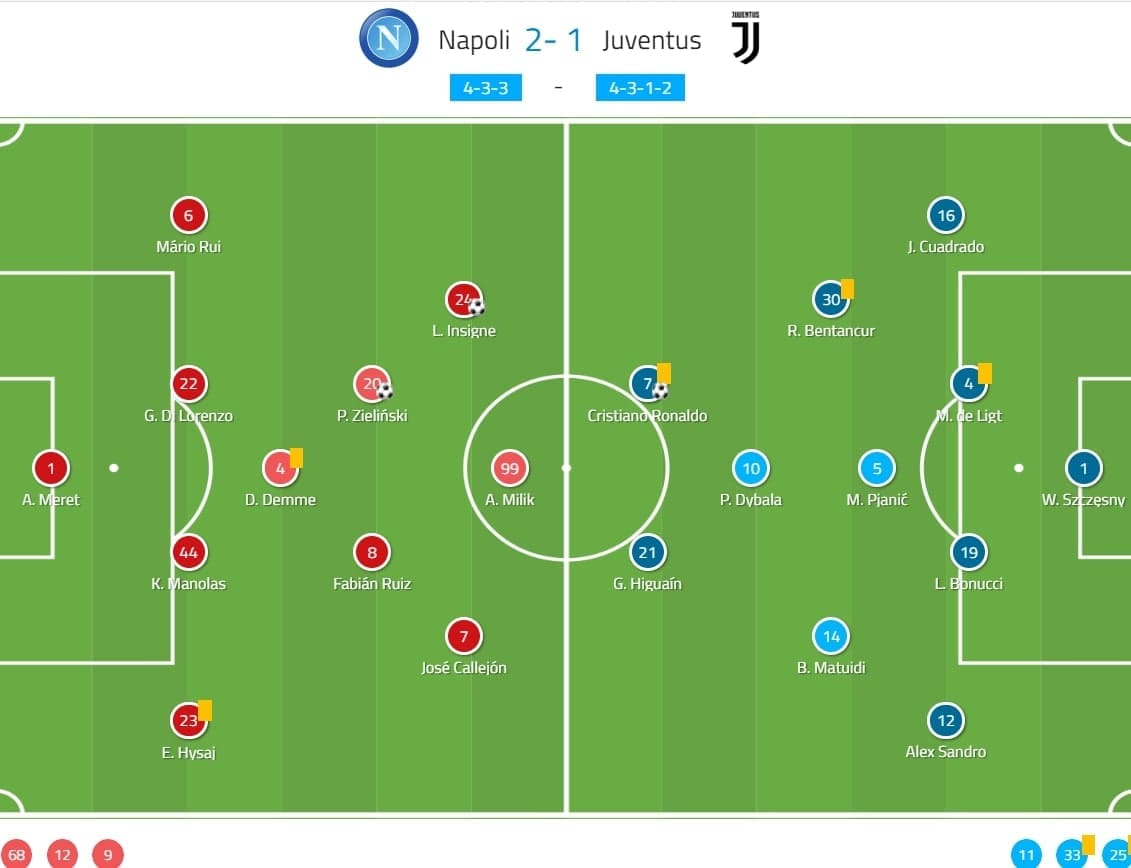
The attack of Juventus
Juventus had some problems with their attack recently. If they intended to play out from the back, their sole pivot, Miralem Pjanić, was usually being marked. Therefore, they felt difficult to penetrate at the centre. Since the formation of Juventus did not contain any wide players, when they were trying to play out from the back, they went to the left, as Ronaldo would drop and provide supports.
We could observe the combinations between Blaise Matuidi, Alex Sandro and Ronaldo. The dropping movements of Ronaldo usually dragged the defenders out, and it created spaces for Juventus players to exploit.
As shown in the below image, which Ronaldo pulled Elseid Hysaj out, Matuidi was running to that space behind the right-back. Both Demme and José Callejón were unaware of the Frenchman.
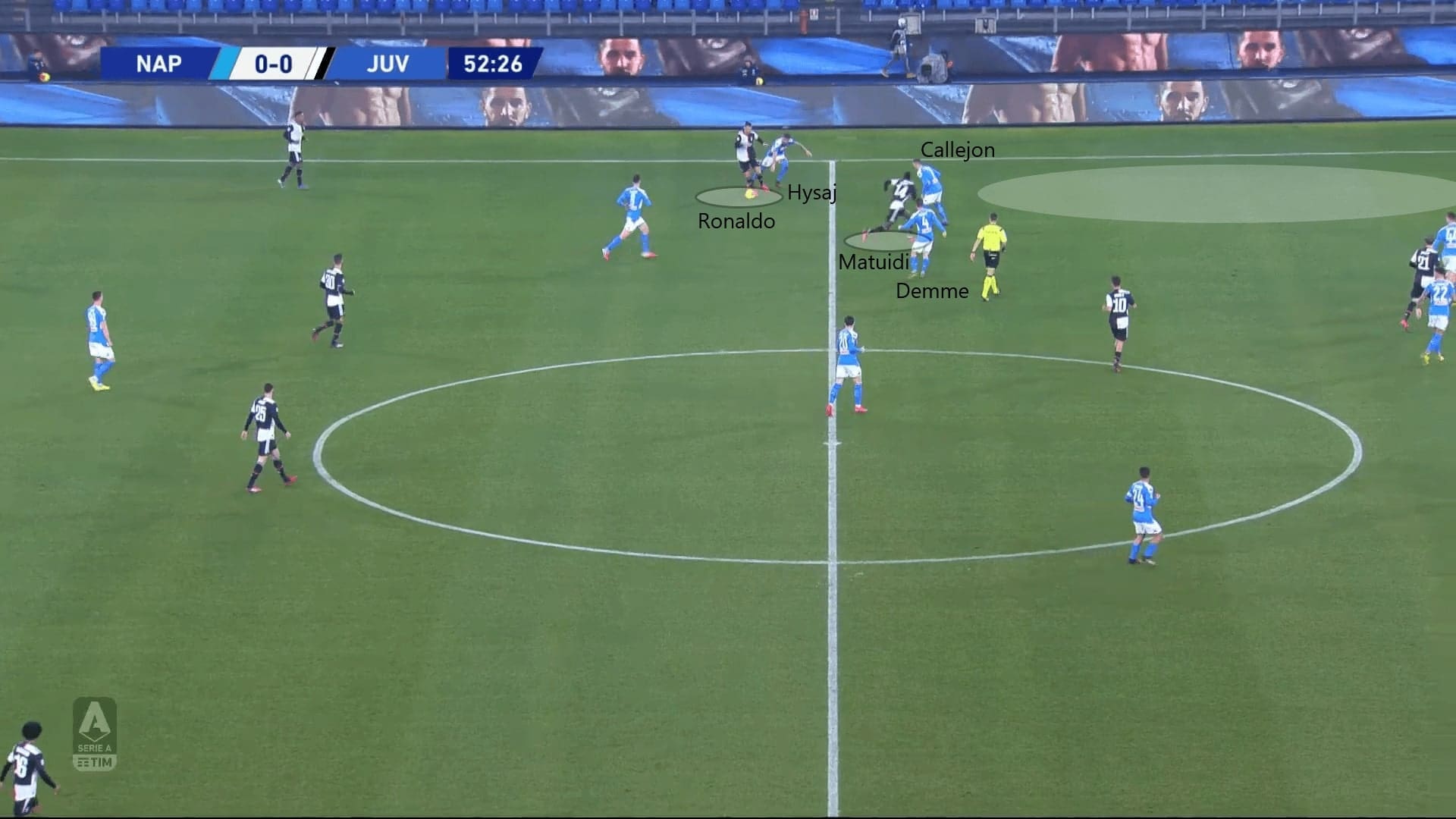
When Juventus entered the final third, and, Ronaldo came inside, he stayed close with Higuain and Dybala. Higuain stayed around the defenders to push them deeper; Ronaldo dropped to provide himself as an option and draw oppositions; meanwhile, Dybala made forward runs to look for spaces behind the defenders. In the below situation, Ronaldo received the ball, turned, and tried to find Dybala, who was running behind Di Lorenzo.
In this match, both Sandro and Juan Cuadrado stayed deeper to prevent the counter-attack of Napoli. We could note that both flanks remained opened and unoccupied, hence, it allowed Napoli’s defensive line to stay compact. Therefore, Ronaldo’s pass was intercepted by Di Lorenzo.
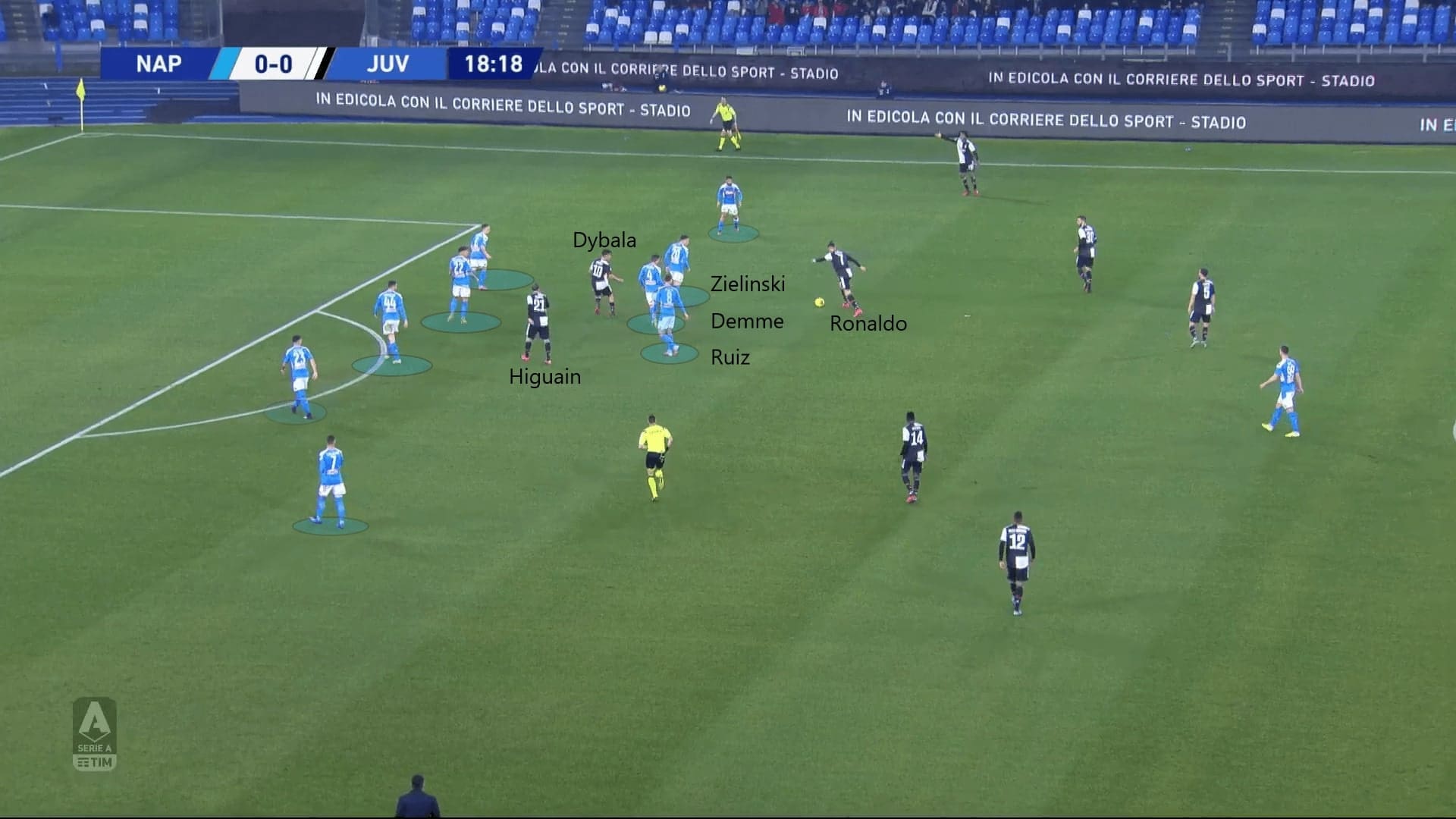
Apart from the attacks which emphasize on vertical passing and attacking spaces behind the lines, Juventus found themselves difficult to break Napoli’s defence. They should have utilized the width more.
Juventus also tried some long balls forward to find the front players directly. However, the accuracy was below par. On average, they played 37.57 long balls per game with 58.16% completion rate. In this game, they only played 31 long balls, and the success rate was 45% only. Napoli managed to deal with the long balls, the winning rate of their defensive duels was 64% in this game.
Defence of Napoli
On occasion, Napoli players pushed high to press. Their intention was not winning the ball high up on the pitch, mainly they were delaying Juventus’ attack. Therefore, they left Juventus centre-backs free, merely blocking the midfielders or forward options. Of course, they also understood the importance of the sole pivot under Sarri’s system, hence, also marked Pjanić.
The following image illustrated the press. When Bonucci passed Sandro the ball, Callejón came forward to pressure the Brazilian. Meanwhile, Milik retreated to close off Pjanić; Ruiz stepped out on Matuidi. As a result, Sandro did not have any short option, he tried to kick it long and the ball was out for a throw-in.
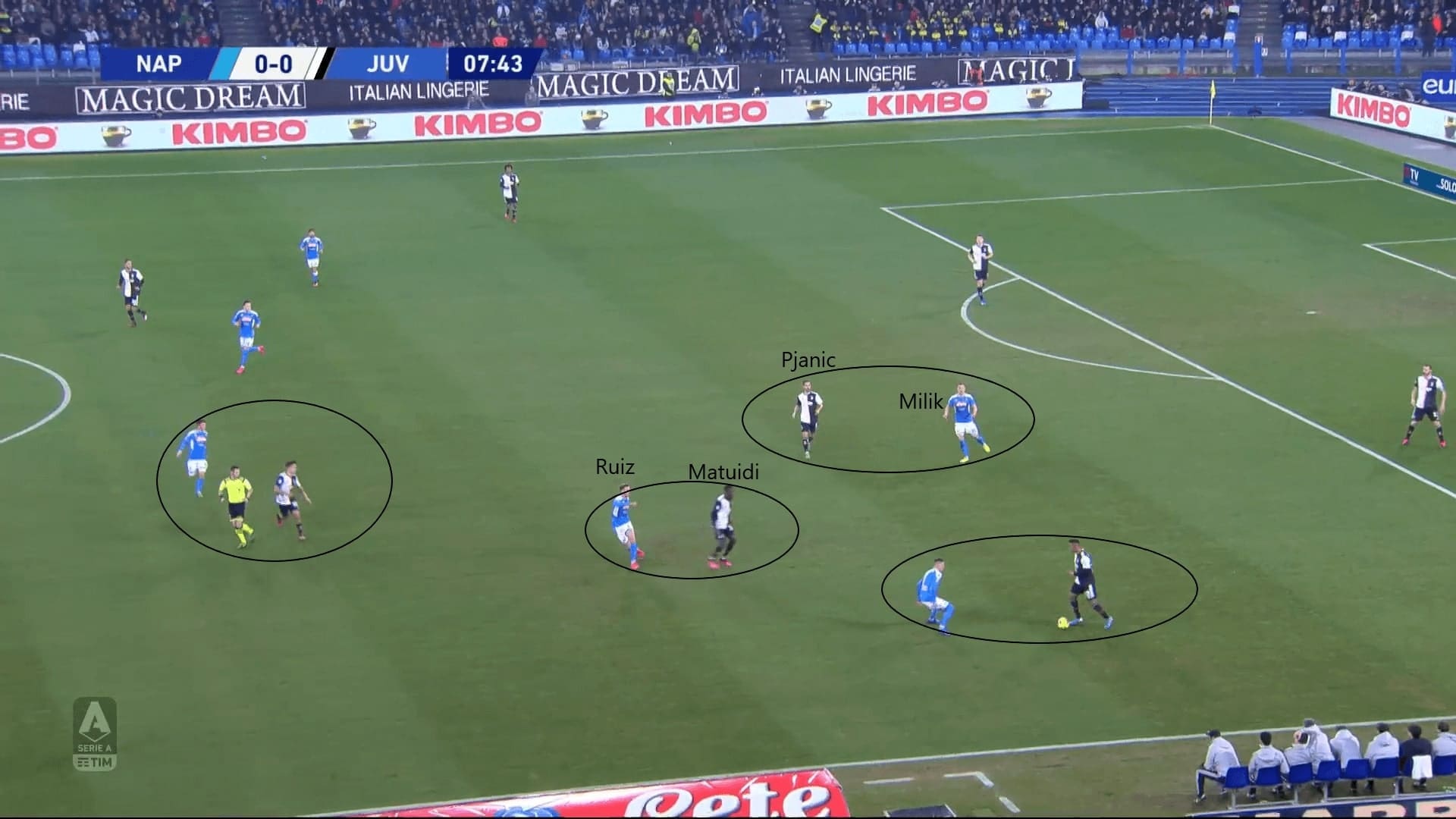
If the first wave of the press did not help Napoli to regain possession, they fell into a 4-5-1 or 4-4-1-1 midblock to defend. Gattuso’s men knew the playing style of Juventus, which emphasized on quick vertical passing. Therefore, Napoli players also press in the central area when Juventus players tried to play a forward press. With the immediate pressure, they forced a return pass, hence, delayed the central penetration and the attack.
Below was a scenario that demonstrated the block of Napoli. They formed a 4-5-1 shape roughly, but their midfielders were stepping out to press the ball back. In hopes of keeping the compactness of the midfielders, when one stepped out, the others should fall back to maintain the shape.
On this occasion, first, Piotr Zieliński pressed Rodrigo Bentancur, also covered Dybala. This forced the Uruguayan passed laterally to Pjanić. When the Bosnian passed to Dybala, Demme provided immediate pressure on the Argentine. Meanwhile, Ruiz, who was retreating, sudden changed his direction to press Matuidi. This further forced the Frenchman to return the ball to De Ligt. Napoli had time to reorganize their defence again.
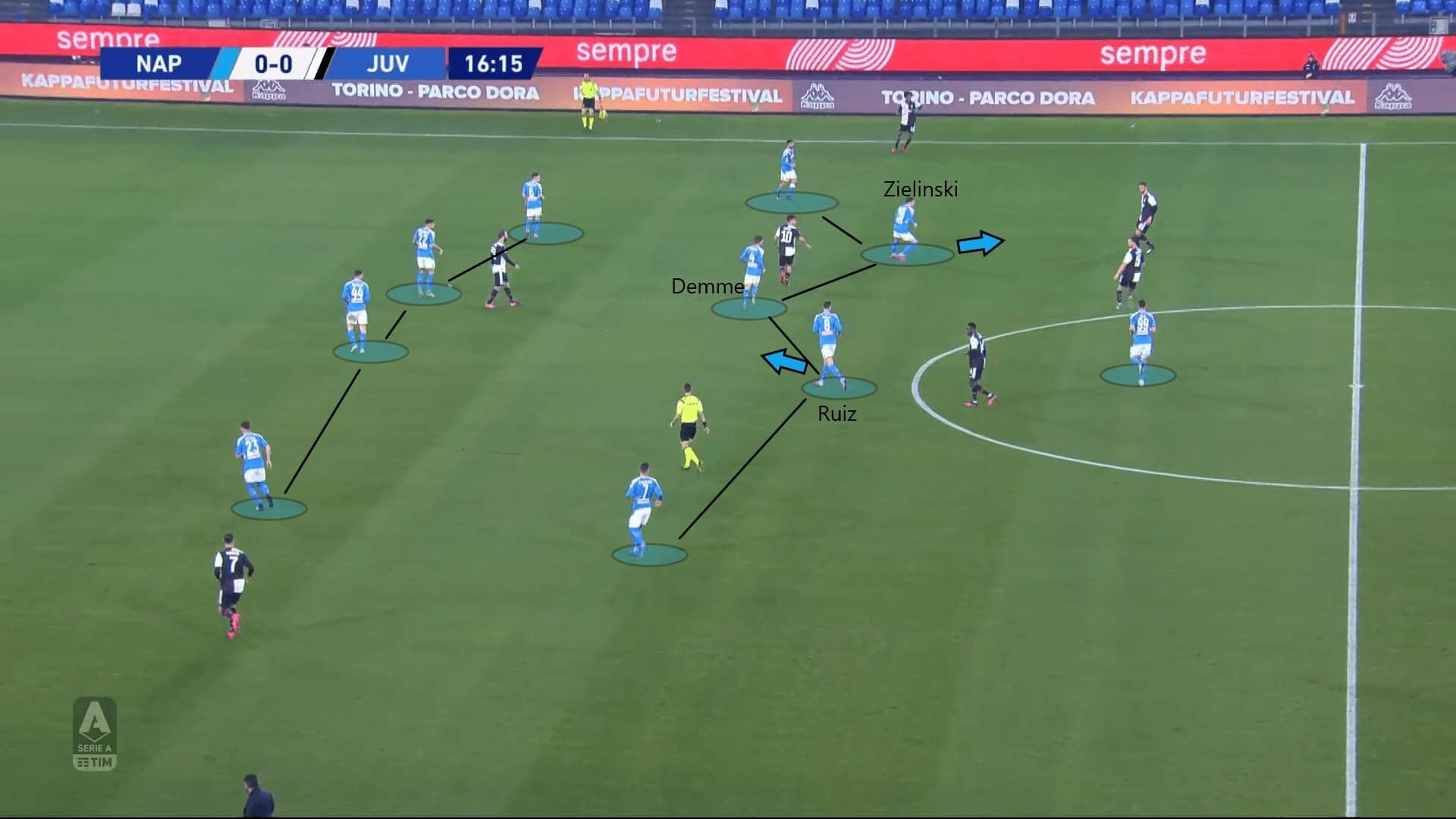
Another key feature of Napoli’s defence in this match was their protection offered to the defenders. Juventus did not have any wide midfielders or wingers to stretch the defence, hence, both lines of Napoli could stay compact. They knew Ronaldo was capable to score a stunner from 30 yards, therefore, they could not let their opponents shoot, even outside of the box.
The following image illustrated the positionings of the midfielders. There were mainly two benefits for the tight positionings between Demme, Ruiz and Zieliński. First, of course, they blocked Ronaldo’s shot. And, for the second, they also covered Higuain and Dybala, prevented a central penetration from Juventus.
Throughout the game, Juventus found themselves difficult to beat this block, their xG was restricted to 0.73. In the first half, Juventus only had three shots, two of them were out of the box, with a total xG of 0.03.

Napoli broke the press
Juventus were not the only team that tried to play out from the back, Gattuso’s Napoli also. At the early stage of the game, Juventus closed the left channel of Napoli, winning the ball in the wide area. However, when the game went on, and, if Juventus started the attack at the centre, Juventus’ press failed.
There were a few ways for Napoli to beat the press. First, they utilized the space between the lines with an extra man. The press of Juventus was separated into two segments, especially when defending the goal kicks. Ronaldo, Dybala and Higuain formed the first line; Pjanić, Matuidi and Bentancur formed the second line. However, they left huge spaces between the lines.
As, on this occasion, Demme returned the ball to Alex Meret, Ruiz was dropping deep to receive the ball without a marker. Since Manolas and Di Lorenzo stretched Higuain and Ronaldo wide, Meret found Ruiz easily.
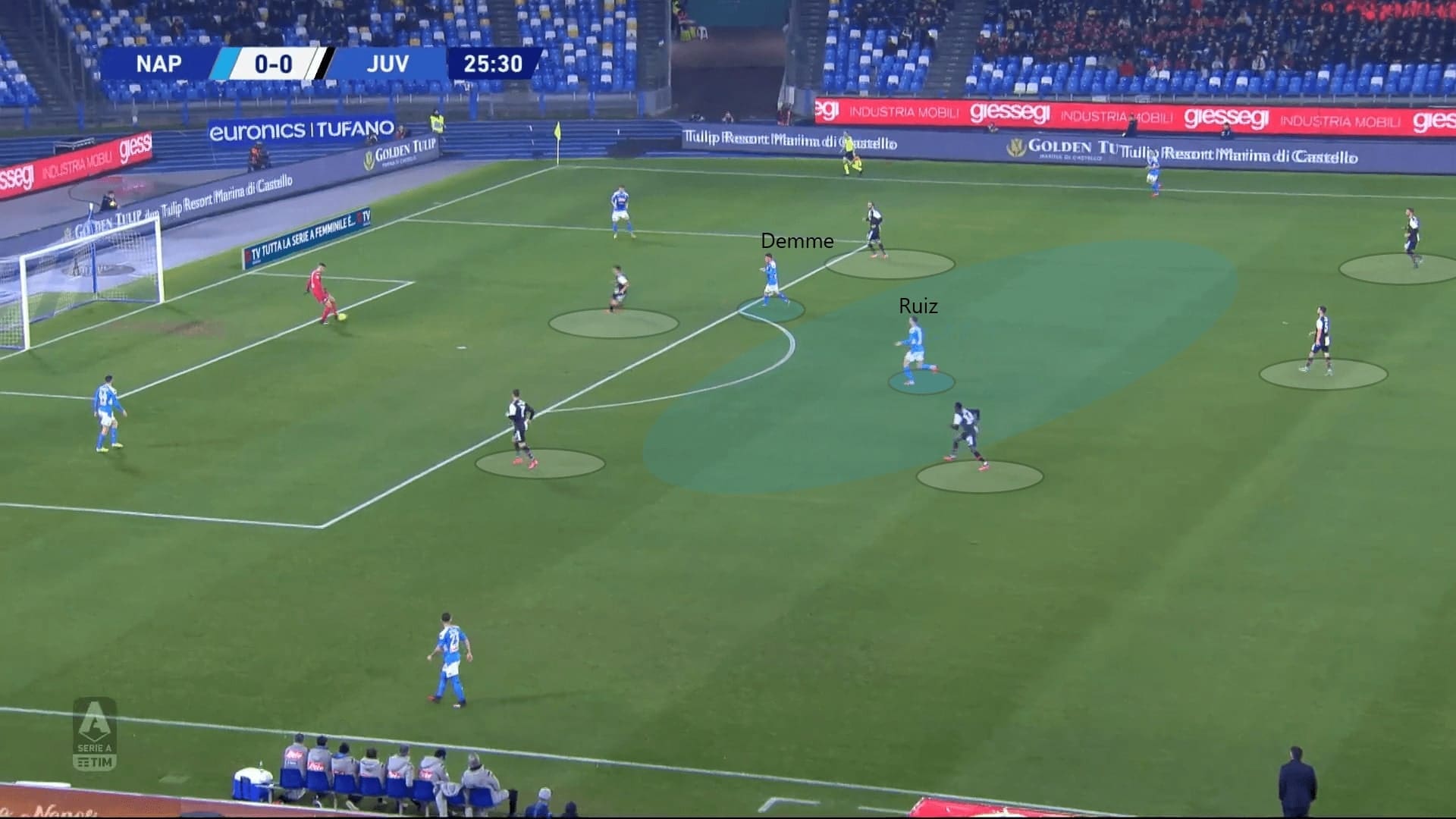
Once Napoli broke the press, with the huge space in front of the midfielders, they could have some choices to progress the ball. The press of Juventus was slightly conservative, as the midfielders did not follow up to press enough.
In this example, when Demme received a pass that eliminated the first defensive line, all three midfielders of Juventus were retreating deeper, instead of providing immediate pressure. The presence of Zieliński could be an explanation, as the Polish positioned himself behind six Juventus players. If he received a pass, Juventus’ defence was exposed.
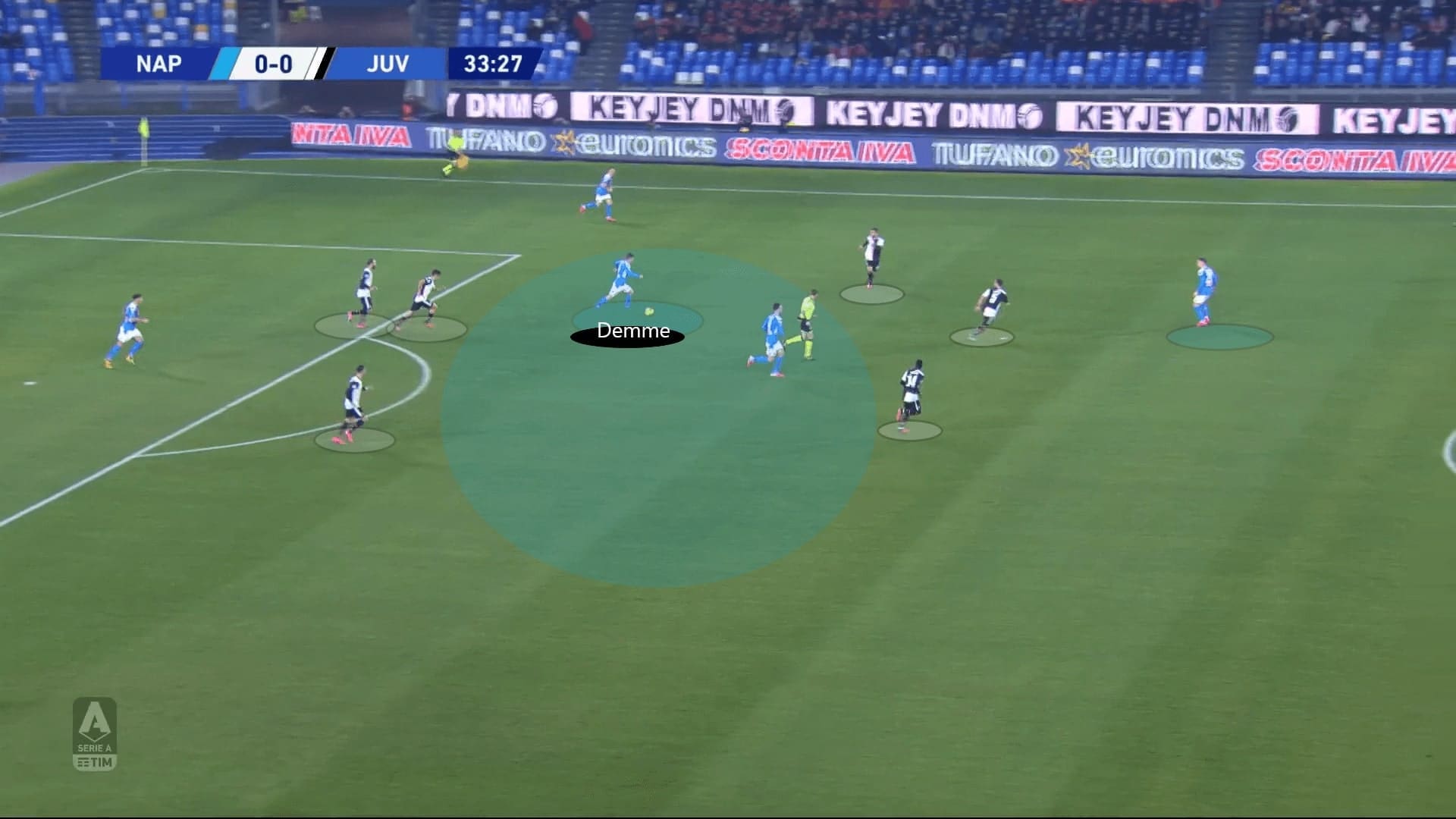
Another way for Napoli to break the press was to utilize the numerical advantage in this phase of attack. Even though Juventus locked the ball side, they were outnumbered as the dropping player of Napoli.
We use the following example to illustrate the case. The general set up of Juventus’ marking was fine, man-marking approach on the pivot; Higuain covered the shadow of Di Lorenzo; Ronaldo was on Manolas, the ball carrier; Matuidi did his job to track Ruiz’s dropping movement. Here is the problem, who was going to mark Hysaj? Juventus did not have a solution in the first half.
On this occasion, Manolas chipped the ball to Hysaj, and Napoli progressed the attack. Juventus should have moved a pivot or a full-back to join the press, at least, reaching numerical equality.
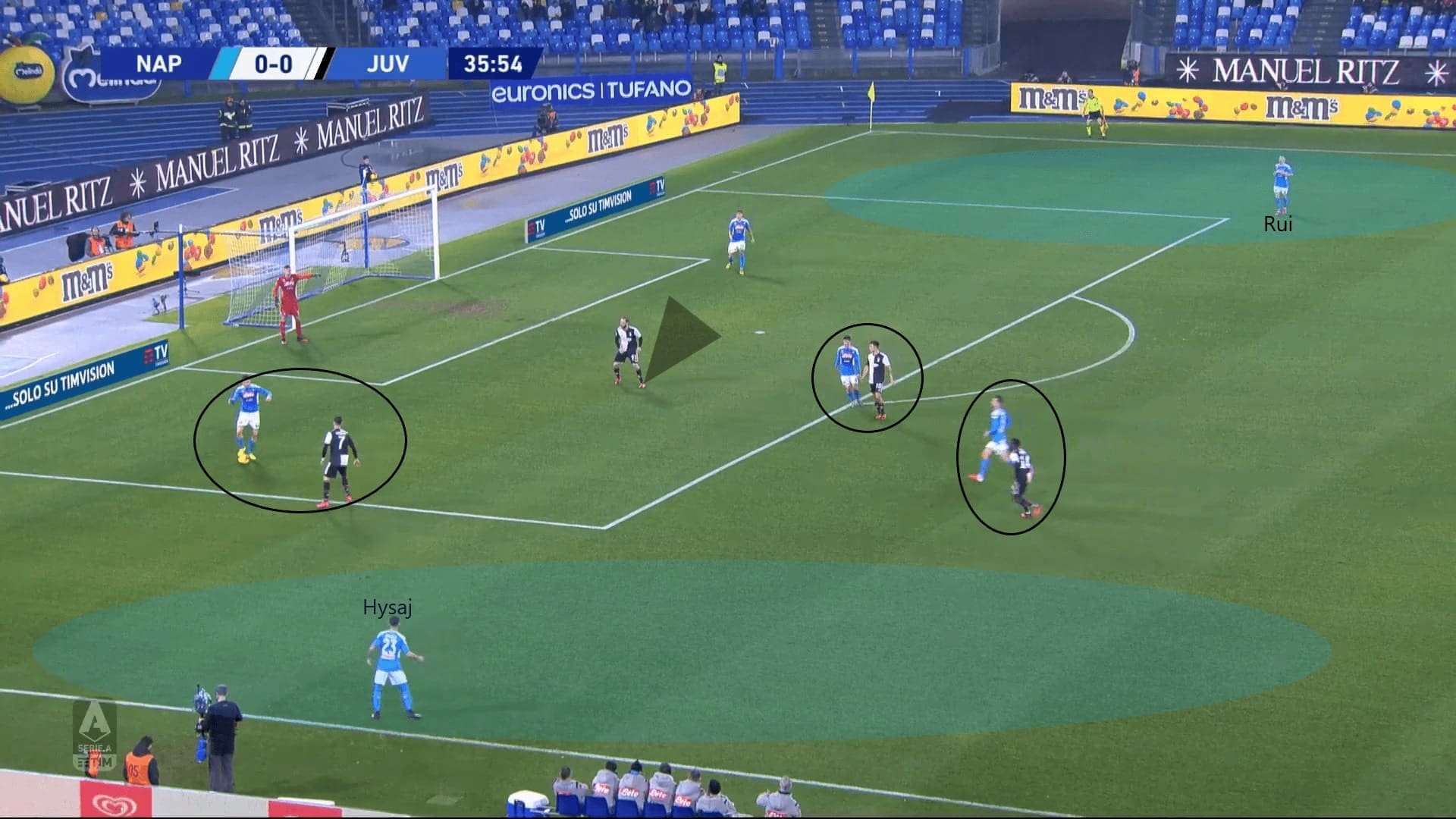
It seemed that Sarri’s team noticed this loophole, and they made adjustments during the break. On this occasion, similar elements occurred. When Napoli’s left-back, Mário Rui was on the ball, the central option, Demme was unavailable since Dybala’s marking. The body orientation of the Portuguese also made the return pass to the centre-back almost impossible.
On this occasion, he was closed off by Adrien Rabiot. And, the dropping Napoli midfielder, Zieliński, was marked by Bentancur, who was playing as a sole pivot now. Rui passed the ball to the Polish, but this was where Juventus won the ball back.
Also, Napoli players were brave to switch plays from side to side, which also helped to eliminate the press.
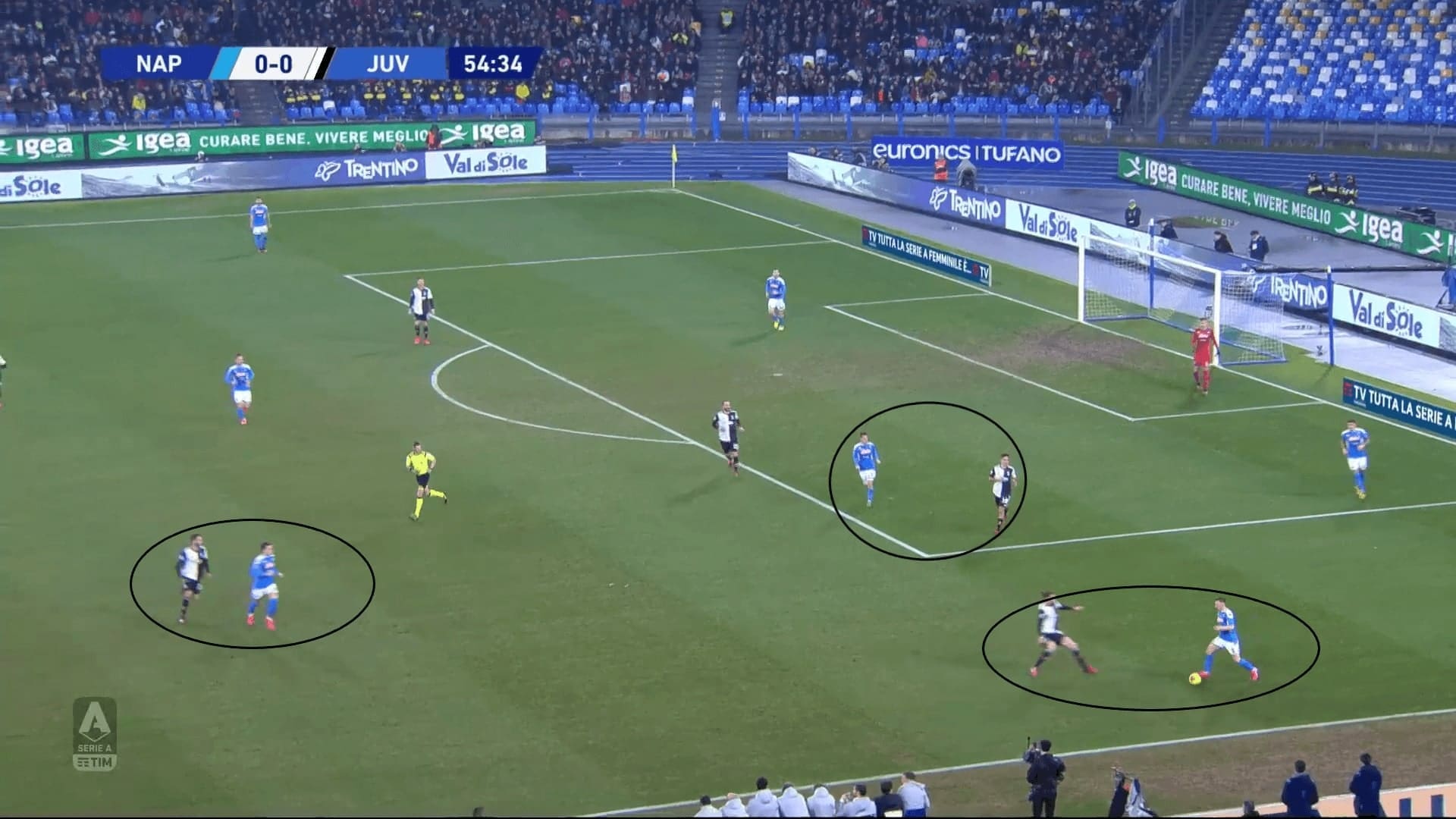
The strong left channel of Napoli
Since Juventus’ press gave Napoli rooms to escape through both channels, Napoli could capitalize on their strengths. One of the strongest combinations were the players on the left. Lorenzo Insigne, Rui and Zieliński. Below is the top passing links map of Napoli, it showed the influence of Napoli’s with a sequence: Di Lorenzo to Rui, Rui to Insigne.
One of the main focuses of Napoli’s attack was Insigne, the Italian handed a bright performance. Apart from the crucial goal (xG: 0.13) he scored, he also completed all four of his dribbles; won five out of six offensive duels; provided six progressive runs; created three shooting chances; drew two fouls. The ability of this individual was the point to give him the ball.
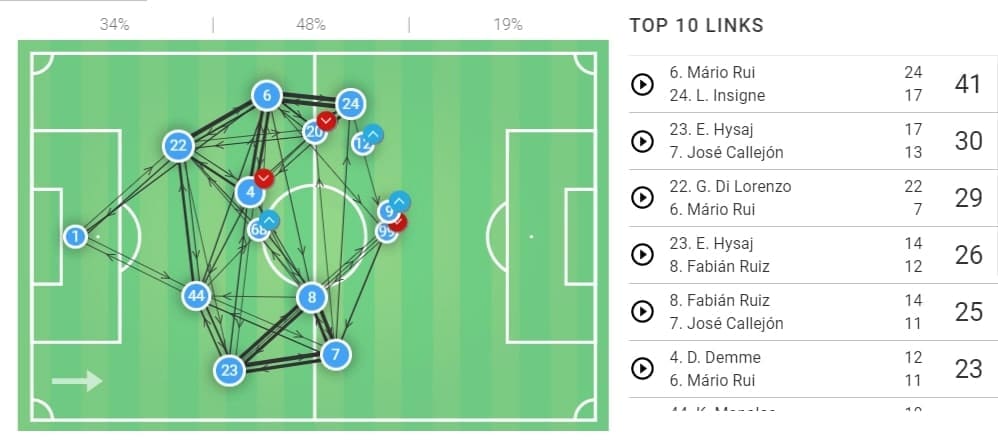
In the following scenario, we give an example of the combination of Napoli’s left-side players. Rui passed the ball to Insigne, got off his marker, Higuain. Since the 28-year-old winger was a right-footed player, when he dropped, he could pass the ball centrally with comfortable body orientation. Meanwhile, Zieliński was making a diagonal run, disrupting Pjanić.
With these movements, two huge important spaces were generated. First, Insigne could quickly pass to Rui, who continued his run. Then, the left-back recognized and exploited the space at the centre. Napoli progressed to the final third.
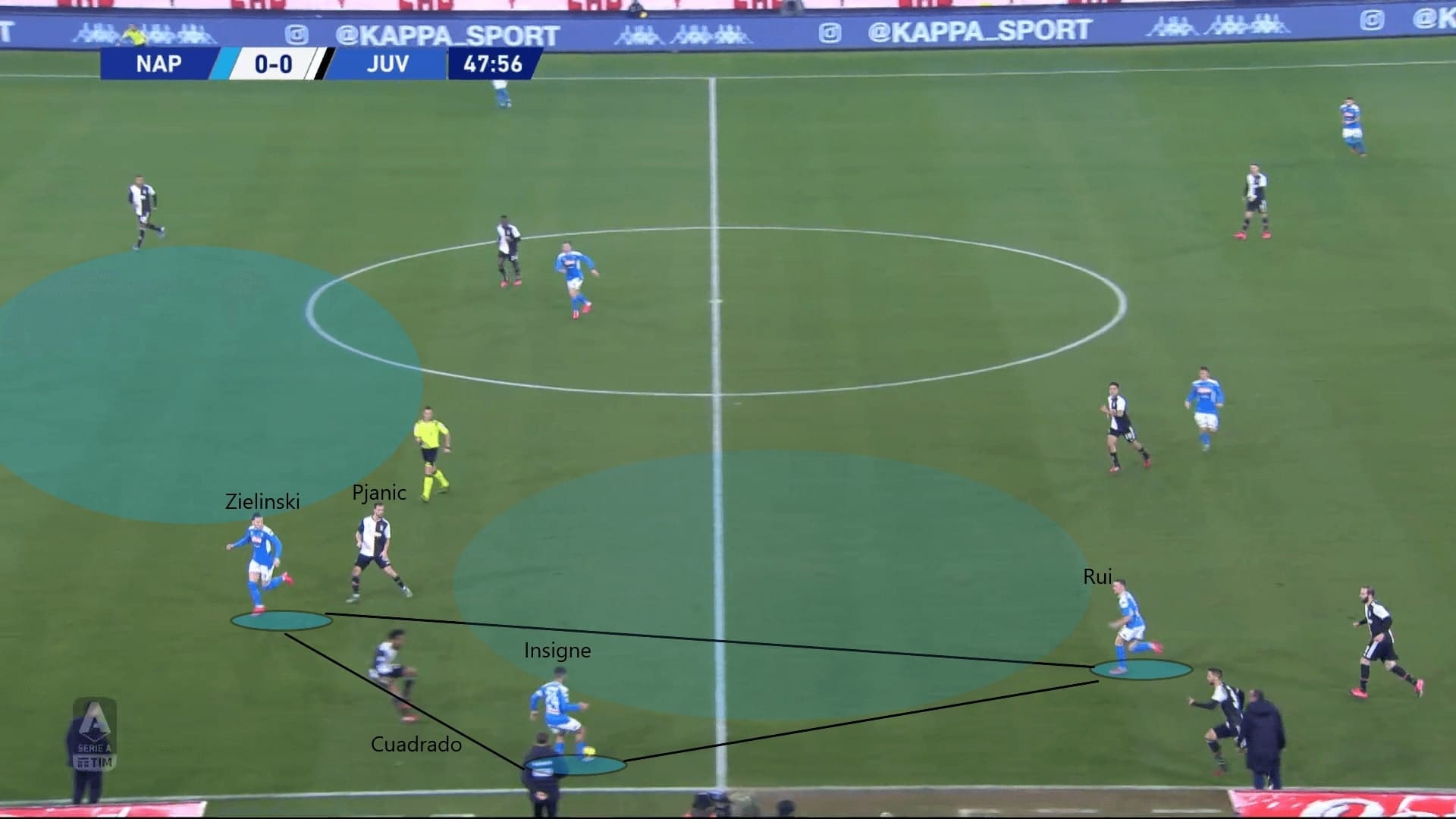
In the offensive transitions of Napoli, Insigne was also a key player who was authorized to carry the ball forward. This was how Napoli scored their first goal.
Conclusion
It was a really important victory for Napoli, Gattuso had been under pressure. It was a difficult task to play without two key players in the team. They recorded an xG of 1.05, with Insigne scoring a beauty. However, it still takes time for Napoli to find their rhythm on both ends, and they are having a relatively easier fixture in the coming games.
Juventus, once again, disappointed their fans. With the quality of the squad, they should have played much better than this performance. Some issues were just repeating in games, their pressing system failed for more than once already. Another concern was the ability of Wojciech Szczęsny’s kicking ability, he made some poor passes under pressure. There were issues for Sarri to solve.





Comments